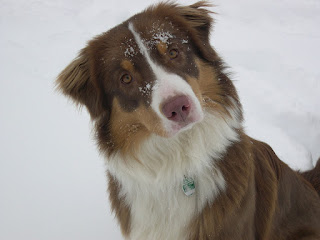While browsing through the Natural Awakenings August issue, I came across an article about communicating with animals through meditation and "Animal Communication" ("Animal Talk: They Have Lots to Say if We'd Only Listen" by Sandra Murphy) It was a hopeful article. I would love to be able to have verbal conversations with the animals who share my home. I don't think I want anyone else to be able to, though, as they would likely share every embarrassing moment I have, with every person who enters our home: "Hey, air conditioning guy! My mom just ran into a door when you rang the doorbell!"
While I can't factually address whether Animal Communication works, I can happily report that it is possible to interpret what your dog is "saying" most of the time through another method. You only need to take a little time to learn about dog body language.
To be able to do it well, you will need to learn to objectively observe your dog. You may have to let go of some assumptions you have previously made about her behavior. Try not to anthropomorphize (to ascribe human form or attributes to [an animal, plant, material, object, etc.] - dictionary.com) when you look at her. In other words, don't assume she's acting guilty because she chewed your favorite shoe. (She's probably just nervous about your reaction.)
So let's get started. Turn around and look at your dog. Look at her:
While I can't factually address whether Animal Communication works, I can happily report that it is possible to interpret what your dog is "saying" most of the time through another method. You only need to take a little time to learn about dog body language.
To be able to do it well, you will need to learn to objectively observe your dog. You may have to let go of some assumptions you have previously made about her behavior. Try not to anthropomorphize (to ascribe human form or attributes to [an animal, plant, material, object, etc.] - dictionary.com) when you look at her. In other words, don't assume she's acting guilty because she chewed your favorite shoe. (She's probably just nervous about your reaction.)
So let's get started. Turn around and look at your dog. Look at her:
- ears
- eyes
- mouth
- tail
- muscle tension
- body posture
- body orientation
 Simply note what you see; are the eyes wide open or soft with half closed lids? Are the ears forward, up, back? Is the tail wagging slowly or stiffly upright? Are any teeth showing, are the lips relaxed or pulled back? Is she gripping the floor with her paws? Is she leaning forward or backward? Is she facing you or lying prone on the floor?
Simply note what you see; are the eyes wide open or soft with half closed lids? Are the ears forward, up, back? Is the tail wagging slowly or stiffly upright? Are any teeth showing, are the lips relaxed or pulled back? Is she gripping the floor with her paws? Is she leaning forward or backward? Is she facing you or lying prone on the floor? Now get up and take a couple of steps toward the door. Look at your dog again. Look at all of the same body parts and positioning. There's a good chance that something has changed. What changed and how? You're on your way to learning to objectively read your dog's body language.
There are reams of information about dog body language available on the internet and in books. For instance, go to this link for a fantastic downloadable poster on dog body language by artist Lili Chin: https://www.flickr.com/photos/lilita/5652847156/sizes/l/. I won't go into detail here about what every change means, therefore. If you have a club or group who would enjoy a presentation on this subject, Affinity Dog Behavior & Training, LLC offers this service.
With practice, you won't even have to think. You'll see your dog or another dog, maybe with stiff body posture, a closed mouth, ears forward and staring, and you'll think, "that dog is worried about something." You may look around and see another dog approaching and you can then make an intelligent decision (maybe based on the other dog's body language!) about whether you should remove your dog from the situation.
You will feel so empowered once you take the time to learn to interpret your dog's language. Notably, you will be able to improve the relationship you have with your own dog. And, by now, hopefully, you know how important that is.
© Tracey Schowalter
Originally posted on http://www.affinitydogtraining.net/the-dogvocat, 8/25/2015













